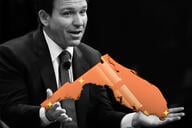You have /5 articles left.
Sign up for a free account or log in.
A federal appeals court on Friday ruled that Michigan voters did not have the right in 2006 to ban public colleges and universities from considering race and ethnicity in admissions.
The 2-to-1 ruling by the U.S. Court of Appeals for the Sixth Circuit was based on the idea that the referendum that voters approved had the effect of denying political rights to minority citizens in Michigan. State officials immediately announced an appeal, which will have the effect of keeping the Michigan ban on consideration of race in place for now.
The challenge to the Michigan referendum was brought by the Coalition to Defend Affirmative Action, Integration and Immigrant Rights and Fight for Equality By Any Means Necessary (known as BAMN) and by 59 black, Latino and Native American students and prospective students of Michigan's public universities. BAMN issued a statement calling the ruling "a great victory for students," and pledging to try to use it to challenge other state bans on the consideration of race in admissions.
Arizona, California, Nebraska and Washington State have bans that are nearly identical to Michigan's. Until Friday, federal courts have declined to throw out the measures. Critics of affirmative action expressed confidence that the ruling would not stand (and, privately, some lawyers sympathetic to affirmative action shared that skepticism).The U.S. Court of Appeals for the Ninth Circuit in 1997 rejected a challenge to California's ban.
Political Rights
Many of the landmark decisions about affirmative action in higher education are based on such issues as the value of diversity in the classroom, the nature of discrimination and disadvantage among those who might not gain admission to leading colleges and universities without the consideration of race, and the impact on white or Asian students of policies to consider race.
Friday's ruling, in contrast, is based on the impact of Michigan's 2006 referendum on minority citizens and their rights to influence state policy (in this case, on public university admissions). Fifty-eight percent of Michigan voters backed the 2006 measure, but exit polls suggested that only 14 percent of black voters did so.
The appeals court found that the referendum "unconstitutionally alters Michigan's political structure by impermissibly burdening racial minorities." The court cited two U.S. Supreme Court rulings overturning referendums that dealt with racial issues. In one case, the citizens of Akron, Ohio, passed a measure requiring a referendum to change fair housing laws (taking away that power from the City Council). In another case, the Supreme Court rejected a state referendum in Washington State that overturned busing programs adopted by the Seattle public schools to promote integration.
In these cases, the Supreme Court questioned referendums that have the impact of removing political control of an issue from one political body to another -- especially when that shift appears to limit the power of minority citizens to express their views through the political process.
In this case, the appeals court found, the admissions policies adopted by universities to consider race in admissions were overturned by the state's voters in ways similar to actions the Supreme Court rejected in Akron and Seattle.
Minority citizens are at a disadvantage under Michigan's ban on the consideration of race, the decision said. An individual seeking to change an admissions policy in Michigan can (if the change does not involve the consideration of race) lobby various faculty and university committees or campaign to elect trustees (as Michigan's three universities have trustees elected in statewide elections). But someone seeking to restore the consideration of race in admissions would have to push for a new vote by the state -- a much more difficult task to accomplish.
"The stark contrast between the avenues for political change available to different admissions proponents following Proposal 2 illustrates why the amendment cannot be construed as a mere repeal of an existing race-related policy," said the decision. "Had those favoring abolition of race-conscious admissions successfully lobbied the universities’ admissions units, just as underrepresented minorities did to have these policies adopted in the first place, there would be no equal protection problem."
A dissenting judge in the case argued that because faculty committees make admissions decisions, the referendum didn't overturn a political decision, but one made by academics at the universities. The dissent -- by Judge Julia Smith Gibbons -- cited evidence that the faculty committees with oversight of admissions policies were not swayed by public sentiment, and thus did not act as political bodies.
"Michigan has chosen to structure its university system such that politics plays no part in university admissions at all levels within its constitutionally created universities. The Michigan voters have therefore not restructured the political process in their state by amending their state constitution; they have merely employed it," said the dissent.
The two judges in the majority -- Ransey Guy Cole Jr. and Martha Craig Daughtrey -- were both nominated by President Clinton. Judge Gibbons was nominated by President George W. Bush. One reason some doubt that the full appeals court will uphold Friday's decision is that 10 of its 15 members are Republican appointees.
Michigan, Race and Admissions
The 2006 referendum was a huge defeat for defenders of affirmative action. Just the year before, the U.S. Supreme Court had used two cases involving the admissions policies of the University of Michigan to uphold the right of public colleges and universities to consider race in admissions (in certain circumstances). Statewide bans on affirmative action have tended to have the greatest impact on flagship universities like Michigan and on professional schools.
In the wake of the 2006 measure, Michigan saw a drop in the percentage of underrepresented minority students admitted to its freshman class from 12.6 percent in the year before it, to 9.1 percent two years later (although the numbers have rebounded some since then).
The university released a statement Friday that said in its entirety: "The university is reviewing the possible implications of the court's decision, and recognizes that there may be further legal steps as well."




